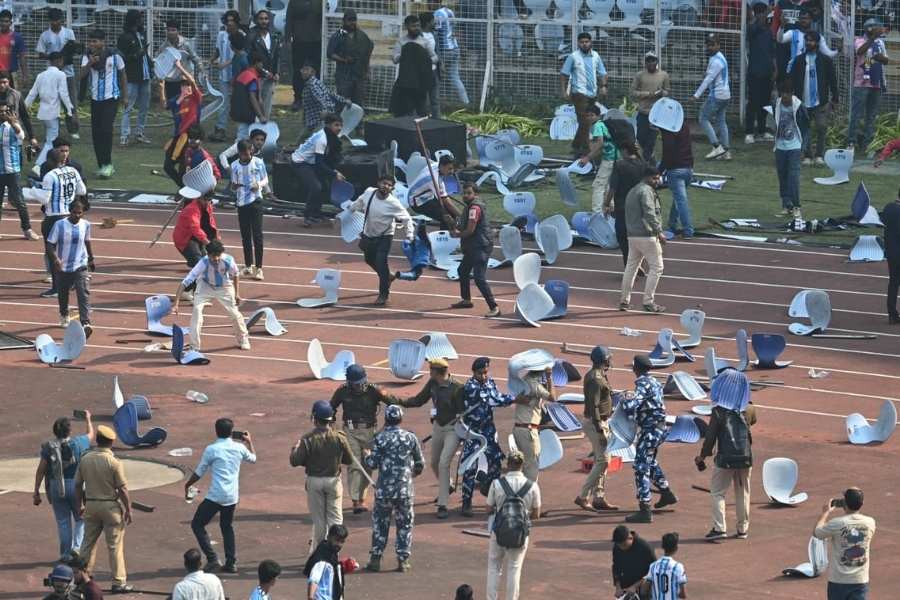
The Kalbaisakhi, as the Nor'wester in north-eastern India is known, is made out to be either about art or artifice - depending on whether you are reading Tagore or the daily news. The reality, however, is an ingenious climatic occurrence full of some intricate science, all thrown together by the blind watchmaker.
This year, Calcutta has already witnessed two instances of Kalbaisakhi in March. There has also been one in Malda and thunderstorm with hail in Jhargram and Coochbehar. But if you are living or have lived in and around Bengal, Bihar, Jharkhand, Assam and Odisha, you would have heard the perennial refrain: "The Kal-baisakhi is not as frequent as it used to be."
Is there any truth in it or is it just nostalgia? Is there indeed a desirable frequency? These are some of the questions that come to mind.
The Nor'wester, for that is what the Kalbaisakhi is, derives its name from the season of its occurrence - the month of Baisakh. In March, April and May, when there is sufficient moisture at the lower level of the atmosphere and cold dry air at the upper level, a divergence occurs at the upper level and a convergence at the lower level, and all of this leads to instability of the atmosphere and consequent convective activity. "Once the convective activity lifts the moisture off the ground to higher up, condensation happens resulting in formation of cumulo nimbus clouds and there is thunder, lightning, squall and rainfall," explains Sanjib Bandyopadhyay, Indian Meteorological Department's (IMD) deputy director general (eastern region).
He argues that all weather patterns have an "inherent variability" both year on year and region wise, and the Kalbaisakhi is no exception. Bandyopadhyay cites Kalbaisakhi associated rain data from April-May 1981 to 2010 - an average of 200mm in South Bengal and 400 to 450mm in North Bengal - to back his claim that all is well.
But even newspaper reports from 1999 and 2000 harp on the diminished frequency of the violent storm. Is it possible that global warming has done its bit? Bandyopadhyay will hear none of this. He concedes that in the last 100 years there has been a lot of environmental change brought about by human activity; but according to him there is "just not enough existing study anywhere" to link global warming to a mesoscale occurrence such as this. A mesoscale phenomenon is something that has a dimension of 1-100km, a height of 1-10km, and lasts for anything from an hour to a few hours.
While there may be no study to link Kalbaisakhi to global warming, there's research linking it to pollution. Professor Sutapa Chaudhuri is the founder co-ordinator of the department of Atmospheric Sciences, University of Calcutta (CU). She has done extensive research on thunderstorms of Gangetic West Bengal. She says, "Pollution has a direct and indirect effect on weather and atmosphere... Investigation shows that clouds form at lower altitude under the polluted conditions compared to clean conditions. The surface pollutants easily get injected into the low clouds with the help of strong wind flow." These pollutants lead to shrinking of clouds, decreasing the possibility of thunderstorms.
Chaudhuri stresses that while Kalbaisakhis may have decreased in frequency, their intensity has increased. Also, the rate of lightning flash has gone up.
Malay Mukhopadhyay, senior professor of Geography at Visva-Bharati University, Santiniketan, has co-authored a paper "A Perception Study on Kalbaisakhi in the neighbourhood of Santiniketan, West Bengal". He mentions that village folk around the Santiniketan area blame technological interference for infrequent Kalbaishakhis.
"Between April and May when the ground gets hot, low pressure is created and that leads to Kalbaisakhi. But now irrigation has meddled with the microclimate. Cultivation of the summer paddy means the fields remain inundated with water. The ground doesn't get hot and the cycle is interrupted," says Mukhopadhyay.
But if we indeed have fewer Kalbaishakhis, why are there so many storm-related deaths? Mukhopadhyay blames senseless bravado. "In the olden times people knew better than to challenge nature. Now, one will venture out in the storm imagining nothing will happen."
Senior scientist at IMD, Devendra Pradhan, merely underlines the phenomenon. "The distance between cloud and ground is about 8km and therefore, the impact of lightning on humans and animals is fatal."
But why has the lightning flash rate gone up, especially over Calcutta? According to Chaudhuri, this is because urban areas are prone to long-term aerosol pollution, which in turn impacts the weather. High clouds retain aerosol particles above 0° C level, and in doing so swell in dimension. More aerosol inside the cloud means more collision and lightning discharge.
Metereologists do not seem to agree on the frequency debate, but there is no argument about the Kalbaisakhi's benefits. The associated rains, a bonus reserved for this geography, are a godsend for the pre-kharif crop, the grass that makes for cattle fodder and the summer fruits. The strong wind kills worms and insects and restores ecological balance. "Villagers regard it as a positive force and call it the Shubaisakhi," says Mukhopadhyay.
Poets have little use for the unnuanced. For them the romance of the Kalbaisakhi inheres as much in its manifestation as in its name, a juxtaposing of contraries.
With all that attention one is bound to play hard to get! No?










